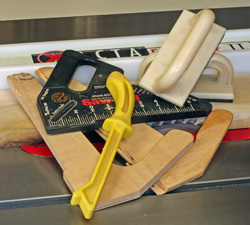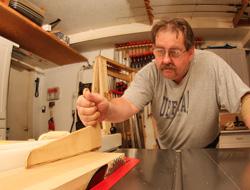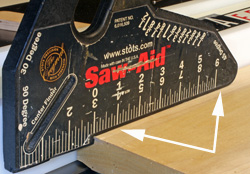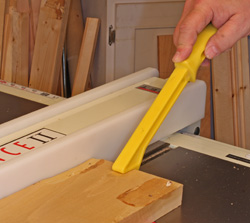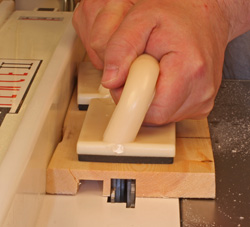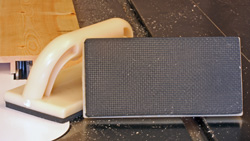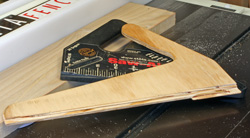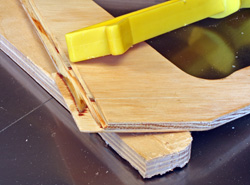This is a Veteran Owned site
 |
||||||||||||||||||
Using Push Sticks
A simple, effective way to increase your safetyText, photos & video by Tom Hintz Updated - 7-6-2011 Warning: Despite our best efforts, woodworking remains dangerous. Even the best practices and push devices cannot guarantee absolute safety. Woodworkers have to evaluate their work habits to be sure they are being as safe as possible. If you are at all uncomfortable with a procedure, stop and find a better solution before continuing. Accidents happen fast, and you may not have a second chance.When you get right down to it, there are two kinds of woodworkers: those who use push devices, and those with an unusual need to be called “Stubby.” Overall, woodworkers are very safe when operating their machinery. However, when accidents do happen, woodworkers are usually at fault. Barring an extremely rare failure of the machine, accidents happen because the woodworker made a mistake. Danger Zones
Most woodworking machines have cutting edges designed to remove wood, do it efficiently, and last a long a time. Admirable features when working with wood, but devastating when applied to a body part or two. It is easy to convince ourselves we will not make such a mistake, but we are all subject to complacency, an inherent human frailty, which means we just might. While there certainly are other ways of getting hurt in a woodworking shop, contact with the cutter appears to be the most common. See "Safety Survey" on this site for some very revealing facts discovered in our own safety survey conducted last year. Disappearing WoodThere is a phenomenon in woodworking I call "disappearing wood." When things go wrong the wood being cut often kicks out of the machine, commonly called "kickback." The problem is this usually happens so fast the operator seldom sees the wood leave but rather hears it hit something behind them, or feels the pain where it impacts their body. During this moment while the mind processes what is happening, your hands continue pushing towards the cutter, now unimpeded by the wood. The result can be a nearly instantaneous cutter/hand accident that can have devastating results. Safety Through Separation
The best way I know of to minimize risk in these situations is to distance body parts from the area of the cutters. For decades, smart woodworkers have used some form of "push stick," a general term that describes a wide range of hand-held devices used to push stock through a machine while keeping hands some distance from the cutter. Whether homemade or commercially produced, the idea is for the push stick to replace your hands near the cutter, and to take the punishment should things go wrong. Saw-AidMy favorite push device on the table saw is the Saw-Aid, manufactured in the USA by Stots (www.stots.com). (I also use the Saw-Aid, when possible, on the router table.) The Saw-Aid features an extended forward gripping surface that gives me a much better feel of control over the workpiece. The length allows me to hold (steer) the work piece firmly against the fence as I push it through, which greatly reduces the chance of experiencing a kickback. Even with a good, properly adjusted splitter in place, wood can rotate anywhere along the width of the blade or cutter before it reaches the splitter and be thrown back. Push BlocksAnother favorite push device in my shop is the push block, normally associated with jointers. The rubber pad on the bottom often provides a better grip on flat stock in addition to removing your hands from the immediate area of the cutter.
Another thing I like about these blocks is being able to walk long stock through the table saw, jointer or router table with a hand-over-hand sequence using two blocks. Most push blocks have a molded handle that affords a good grip while adding a little distance between you and the cutters. The handle is often angled slightly to keep your hand clear of the fence. I also use these push blocks on the router table when working with small stock because of the control they give while keeping my fingers removed from the bit. Notched Push SticksThe least favored push device in my shop is the traditional stick with a notch at the end that catches over the edge of the wood. I feel this design offers the least control and often encourages the use of another push stick applied to the side of the work piece to help keep it against the fence. This can lead to trouble especially if side pressure is applied near or beyond a saw blade, closing the kerf and begging for a kick back. Homemade Problem Solvers
I also use push devices made in my own shop, loosely based on the Saw-Aid design. These versions are for the rare occasions when the cuts are too narrow for the Saw-Aid (1/2-inch-wide) to safely pass between the blade and fence. I cut these push devices from plywood of the widest thickness that will fit the cut being made. While it is tempting to make push handles from very thin ply or hardboard, I do not go below ¼-inch-thick ply to make sure the push device will not break, twist or otherwise fail during use. If cuts thinner than ¼-inch are needed (between the blade and fence), and I have not encountered one yet, think of a different way of doing it. Having Push-Sticks is Not EnoughJust having push devices in your shop is not enough. We have to train ourselves to use them whenever the size of the wood being worked with brings our hands within comfortable distance of the cutter. I consider 12-inches (minimum) to be too close to a cutter. Your comfort zone may differ, but make sure you consider the worst-case scenario. If you feel at all uncomfortable about where your hands are, they are far too close to danger.
It is also important to remember that just because you are using a push device you are not Superman. I have heard of situations where the wood kicked out, followed closely by the push device being knocked out of the operators hand by the same cutter. We have to constantly be aware of the dangers associated with using woodworking machinery. Those dangers can be minimized only by using proper safety equipment applied with safe procedures. To some, using push devices can feel a bit awkward. With a little practice this usually subsides. Since starting to use the Saw-Aid and other push devices in my shop, I now prefer them to bare hands in all situations aside from large pieces of sheet stock. Using push devices will not increase the time an operation takes, nor reduce the quality of the cut. They do make woodworking safer, something all of us should be very interested in. Do you have a comment about this page? - Email Me! |
||||||||||||||||||
All written, photographic and drawn materials are property of and copyright by NewWoodworker.com LLC 2000-2019. Materials may not be used in any way without the written permission of the owner.

